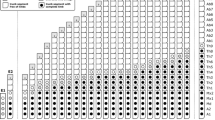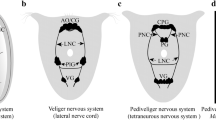Abstract
Comparative features of the development of the larval nervous system of ophiuroids have the potential for resolving aspects of echinoderm evolution. In Amphiura filiformis serotonergic neural progenitors appear in the animal plate of late gastrulae. The serotonergic progenitors increase in number and become displaced to the aboral ectoderm side of the developing ciliary band. The ciliary band neurons appear as irregularly spaced neural progenitors on the oral side of the ciliary band lateral to the mouth. These cells extend neurites along the axis of the ciliary band, which meet at the center of the ventral transverse ciliary band. The larval nervous system begins as a U-shaped tract of axons that surrounds the oral field and tracts of axons and neurons in the ciliary bands of the larval arms are added. In addition, the larval nervous system has an extensive pre-oral neuropil, rings of nerves surrounding the anus and pyloric sphincters, and a plexus of axons that surround the esophagus. The nervous system of the juvenile develops beneath the oral ectoderm. The components of the adult nervous system: five segments of radial nerve, commissures that form the nerve ring, and podial nerves all appear as the juvenile develops. The larval nervous system begins to fragment and degenerate as the juvenile grows. The complete description of neural development of an ophiuroid reveals that the four classes so far investigated are consistent with phylogenies based on adult features and comparisons of neural organization help rationalize conflicting hypotheses of the evolution of larval forms in echinoderms.





Similar content being viewed by others
References
Beer AJ, Moss C, Thorndyke M (2001) Development of serotonin-like and salmfamide-like immunoreactivity in the nervous system of the sea urchin psammechinus miliaris. Biol Bull 200(3):268–280
Bishop CD, Burke RD (2007) Ontogeny of the holothurian larval nervous system: evolution of larval forms. Dev Genes Evol 217(8):585–592
Burke RD, Angerer LM, Elphick MR, Humphrey GW, Yaguchi S, Kiyama T, Liang S, Mu X, Agca C, Klein WH, Brandhorst BP, Rowe M, Wilson K, Churcher AM, Taylor JS, Chen N, Murray G, Wang D, Mellott D, Olinski R, Hallbook F, Thorndyke MC (2006) A genomic view of the sea urchin nervous system. Dev Biol 300(1):434–460
Byrne M, Nakajima Y, Chee FC, Burke RD (2007) Apical organs in echinoderm larvae: insights into larval evolution in the ambulacraria. Evol Dev 9(5):432–445
Cisternas PA, Byrne M (2003) Peptidergic and serotonergic immunoreactivity in the metamorphosing ophiopluteus of ophiactis resiliens (echinodermata, ophiuroidea). Invertebr Biol 122(2):177–185
Cobb JLS, Stubbs TR (1981) The giant-neuron system in ophiuroids. 1. The general morphology of the radial nerve cords and circumoral nerve ring. Cell Tissue Res 219(1):197–207
Cobb JLS, Stubbs TR (1982) The giant-neuron system in ophiuroids. 3. The detailed connections of the circum-oral nerve ring. Cell Tissue Res 226(3):675–687
Hirokawa T, Komatsu M, Nakajima Y (2008) Development of the nervous system in the brittle star amphipholis kochii. Dev Genes Evol 218(1):15–21
Hyman LH (1955) The invertebrates: Echinodermata, 5
Janies D (2001) Phylogenetic relationships of extant echinoderm classes. Can J Zool 79(7):1232–1250
Littlewood DTJ, Smith AB, Clough KA, Emson RH (1997) The interrelationships of the echinoderm classes: morphological and molecular evidence. Biol J Linn Soc 61(3):409–438
Nakajima Y, Humphreys T, Kaneko H, Tagawa K (2004a) Development and neural organization of the tornaria larva of the hawaiian hemichordate, Ptychodera flava. Zool Sci 21(1):69–78
Nakajima Y, Kaneko H, Murray G, Burke RD (2004b) Divergent patterns of neural development in larval echinoids and asteroids. Evol Dev 6(2):95–104
Nakano H, Murabe N, Amemiya S, Nakajima Y (2006) Nervous system development of the sea cucumber Stichopus japonicus. Dev Biol 292(1):205–212
Nezlin LP, Yushin VV (2004) Structure of the nervous system in the tornaria larva of balanoglossus proterogonius (hemichordata : Enteropneusta) and its phylogenetic implications. Zoomorphology 123(1):1–13
Nielsen C (2005) Larval and adult brains. Evol Dev 7(5):483–489
Nielsen C, Hay-Schmidt A (2007) Development of the enteropneust ptychodera flava: ciliary bands and nervous system. J Morphol 268(7):551–570
Smith AB (2005) The pre-radial history of echinoderms. Geol J 40(3):255–280
Strathmann RR, Eernisse DJ (1994) In: What molecular phylogenies tell us about the evolution of larval forms. Amer Soc Zoologists, pp 502-512
Stubbs TR, Cobb JLS (1981) The giant-neuron system in ophiuroids. 2. The hyponeural motor tracts. Cell Tissue Res 220(2):373–385
Whittaker CA, Bergeron KF, Whittle J, Brandhorst BP, Burke RD, Hynes RO (2006) The echinoderm adhesome. Dev Biol 300(1):252–266
Acknowledgements
These studies were supported by the Royal Swedish Academy of Sciences, Broderna Jacob och Marcus Wallenbergsfond; H. M. Kongungens Wallenbergsfond; Knut och Alice Wallenbergs Stiftelse; Vetenskapsrodet, Sweden, and NSERC (Canada)
Author information
Authors and Affiliations
Corresponding author
Additional information
Communicated by
H. Nishida
Rights and permissions
About this article
Cite this article
Dupont, S., Thorndyke, W., Thorndyke, M.C. et al. Neural development of the brittlestar Amphiura filiformis . Dev Genes Evol 219, 159–166 (2009). https://doi.org/10.1007/s00427-009-0277-9
Received:
Accepted:
Published:
Issue Date:
DOI: https://doi.org/10.1007/s00427-009-0277-9




